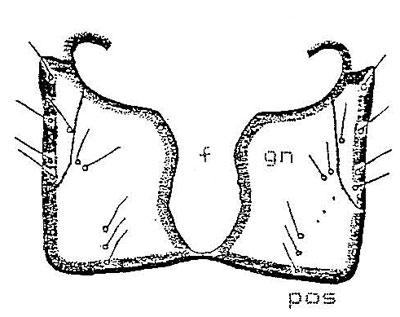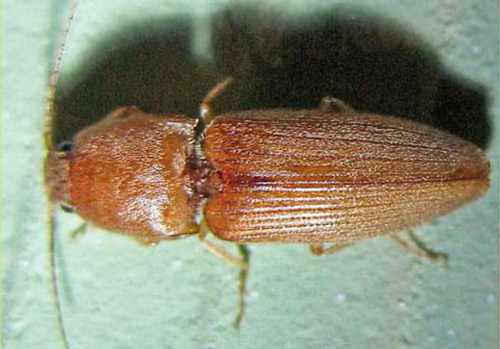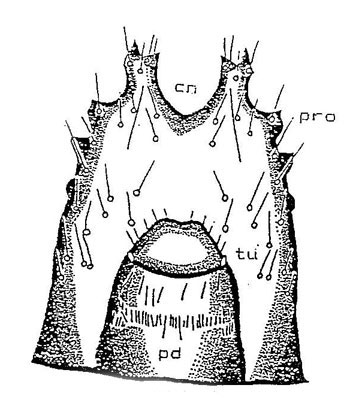common name: a wireworm
scientific name: Conoderus scissus Schaeffer (Insecta: Coleoptera: Elateridae)
Introduction - Distribution - Description - Identifying Characteristics of Mature Larva - Life Cycle and Biology - Hosts - Economic Importance - Management - Selected References
Introduction (Back to Top)
The wireworm Conoderus scissus Schaeffer is an important pest of root and tuber crops. It is also known as the peanut wireworm.
Distribution (Back to Top)
Conoderus scissus is distributed in the coastal plain of southeastern United States (Hoffman 2007). It has been reported from Georgia (Schaeffer 1909, Van Dyke 1932, Fattig 1951), North and South Carolina (Kirk 1970), Mississippi (Lago and Testa 1989), and Florida (Peck & Thomas 1998).
Description (Back to Top)
Adult: The adult is brown, and is unique for its uniform color pattern which makes it easier to separate from other member of the genus. The average body length and width are 10.22 mm and 1.98 mm, respectively.
Figure 1. Adult Conoderus scissus Schaeffer, a wireworm. Photograph by Dakshina R. Seal, University of Florida.
Eggs: The eggs are creamy white in color and spindle shaped. The adult lays eggs in the crevices or cracks on the soil surface near the root systems of host plants.
Larvae: The first instar is creamy-white. It is 2.88 to 4.61 mm (avg. 3.67 mm) in length. The prothorax is the widest part of the body. The length of the ninth abdominal segment is greater than other body regions and also greater than the width of the same. The paired urogomphi of the dorsal plate of the ninth abdominal segment show a clear, open 'V' shaped caudal notch. The depth of the caudal notch averaged 0.07 mm.

Figure 2. Mature larva. Head is to the left, 'V' shaped caudal notch is to the right. Drawing by Division of Plant Industry.
The last instar is whitish in color. It is 13 to 18 mm (avg. 15.55 mm) in length. The width of each body region exceeds the corresponding length except for the ninth abdominal segment. Various characters of full grown larvae are important to identify wireworm species.
Identifying Characteristics of Mature Larva (Back to Top)
Frons: The shape of the frontal suture is distinct and is rounded posteriorly against the post occipital sulcus. Anteriorly, there are two sets of two setae inside the frontal suture. Above these sets there is a line of four other setae.

Figure 3. Frons of mature larva. Drawing by Division of Plant Industry.
Gena: On the parietal side of the frons are three setae on the gena near the post occipital sulcus. Three more setae occur on the upper margin of each gena. On the outer margin of the gena, four setae are arranged in a line.

Figure 4. Frons (f) with nasale (n) of mature larva.
Ninth abdominal segment: 1) Dorsal surface. The dorsal plate of the ninth abdominal segment is provided laterally with six prominent protuberances on each side of the urogomphi, each of which is provided with a seta. There is one pair of setae separated by 0.21 mm on the dorsal surface 0.34 to 0.47 mm (avg. of 21 larvae, 0.41 mm) behind the groove of paired urogomphi. The paired urogomphi of the dorsal plate of the ninth abdominal segment show a clear, open 'V' shaped caudal notch.

Figure 5. Dorsal view of ninth abdominal segment showing caudal notch (cn), urogomphi (ur), protuberance (pro).
2) Ventral surface. The tip of the 10th abdominal segment (pseudopod) is eversible and has a tubercle on each side of the base. The pseudopod is covered with three rows of setae, one row around the tip of the pseudopod and the other two rows arranged cephlad.
Figure 6. Ninth abdominal segment ventral view showing pseudopod (pd), tubercles (tu).

